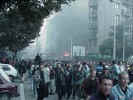NATO's Kosovo mission failed
By Scott Taylor
Mitrovica, Kosovo - IT HAS BEEN three years
since NATO troops first rolled into Kosovo and the last of the Yugoslav security
forces withdrew from this embattled province. At that juncture, the western
media hailed NATO's intervention as the "liberation of Kosovo" and a
victory for Albanian Kosovars. Many misguided military analysts proclaimed the
campaign to be "proof" that overwhelming air power alone was sufficient
to win modern wars.
In actual fact, unexpected Serbian defiance
and the inability of NATO aircraft to locate and destroy the Yugoslav military
had forced NATO to concede to then president Slobodan Milosevic's demands and
negotiate a diplomatic settlement.
Originally, NATO planners had expected the
Serbs to concede after five days of face-saving resistance. No one had planned
for a campaign that would last 78 days without creating a crack in the Serbs'
will to resist.
Likewise, despite the exaggerated daily
claims of destruction by NATO spokesman Jamie Shea, the top brass knew their
planes could not find the well-concealed Serbian forces in Kosovo.
Although Shea boasted of NATO pilots
"killing" over 150 armoured vehicles, it was later confirmed that only
13 Yugoslav tanks were destroyed during the fighting.
Of these, five were, in fact, Second World
War-vintage, U.S.-made M-10 tank destroyers, museum pieces, that were placed in
fields by the Serbs as deliberate decoys.
As a result of the air campaign's failure to
achieve its aims, NATO was forced to sign a peace deal with Milosevic, a man
they had already indicted as a war criminal.
Under the terms of this deal (United Nations
Resolution 1244), an international military occupation force in Kosovo would
also include non-NATO contingents (notably the Russians, who rushed in to seize
the strategic Pristina airport in advance of the NATO forces); the world would
still recognize Kosovo as sovereign Yugoslav territory; the Albanian guerrilla
force known as the Kosovo Liberation Army (KLA) was to be quickly disarmed, at
which time Serbian security forces would be allowed to re-enter the province to
protect historical sites and border posts; and, finally, NATO's demand to hold a
referendum o n Kosovo's independence "within three years" was to be
postponed "indefinitely."
However, what has become obvious over the
past 36 months is that NATO negotiators never had any intention of fully
implementing Resolution 1244. Even after the overthrow of Slobodan Milosevic's
regime, it is apparent that the United Nations Mission in Kosovo is unwilling to
co-operate with Yugoslav authorities.
Furthermore, the KLA was never fully disarmed
and was reconstituted as the UN-funded Kosovo Protection Corps. Despite repeated
protests from Yugoslav negotiators and the destruction of their religious sites,
no Serbian police have been allowed to re-enter Kosovo, in spite of the fact
that this province technically remains part of the sovereign territory of
Yugoslavia.
More importantly, the arguments to justify
NATO's military intervention continue to erode. At the time of the first
bombing, we were led to believe that timely action would prevent a humanitarian
crisis in Kosovo. However, it was two days after the air strikes began that
first a trickle, then a flood of refugees began pouring from the region.
With 800,000 Albanians housed in squalid
refugee camps, NATO spokesman Jamie Shea told us that the bombing had to
continue "because Milosevic was committing genocide."
At one stage, in order to encourage support
for a military ground campaign, the U.S. State Department claimed that as many
as 100,000 Albanians had been slaughtered in Kosovo. However, in the three years
since NATO's occupation, United Nations forensic teams have had difficulty in
identifying even 2,000 victims that would have been killed during the 78-day
crisis. (This number includes over 400 Serbs and 300 other non-Albanians, and
does not distinguish between combatants and civilians.)
Given the final death tally, even the newly
constituted Albanian Kosovo Supreme Court ruled last month that no genocide had
taken place in Kosovo, only the displacement of people. Nevertheless, despite
the presence of 40,000 NATO soldiers and 10,000 international police who patrol
the province, over the past 36 months there have been 1,000 murders and 2,000
people were reported missing.
For the 239,000 Serbs who fled Kosovo in
1999, during the period of Albanian "revenge" attacks, displacement
into refugee camps remains a reality. For the additional 100,000 Serbs and
non-Albanians who stayed in their homes in Kosovo, they continue to live in tiny
enclaves under 24-hour NATO protection. With an unresolved refugee crisis and
continued inter-ethnic violence, it is difficult to understand how NATO
officials, who were responsible for the intervention, can proclaim Kosovo to be
either justifiable or a success.


